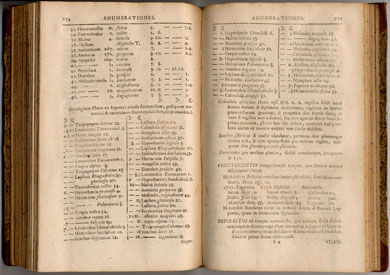Linnaeus’s floral clock – Horologium Florae
Linnaeus and the timekeeping of plants
”Horologium Florae, to see by the opening and closing of flowers what the time is, from morning to evening, was also invented by L. for the benefit of the world.”
from the autobiographical notes of Carl Linnaeus.

Philosophia botanica
In the middle years of the 18th century, Carl Linnaeus became interested in how plants changed over time, in response to the seasons of the year and the day-night cycle. In 1741 he had been appointed Professor of Medicine at Uppsala University, which also gave him responsibility for the University’s botanic garden. Together with his family he moved into the professorial residence at the south-eastern corner of the garden. This was 15 years before he acquired the summer residence at Hammarby, so he spent much of his time within the confines of the botanic garden, both winter and summer. There he could monitor at close quarters, day and night, the changes occurring in the plants growing in the beds and the orangery. Plants that he wanted to study particularly closely were placed in pots in his chamber window. Linnaeus’s son has written that his father ”Worked from 4 in the morning to 10 in the evening.” Linnaeus himself writes in one of his autobiographical accounts that he used to sleep between 10 pm and 3 am in the summer, but that in the winter he would go to bed at 7 pm and not get up until 9 am.
At this time Linnaeus was an energetic young man in his late 30s who also spent a lot of time out in the countryside. During the summer season he would go on weekly Herbationes, nature rambles, with his students in order to teach them about plants, animals and minerals in and around Uppsala. In this way he got the opportunity to study the changes that occurred in the plants over the course of the growing season in their natural locations.
Linnaeus also collected observations during the 1740s when he travelled round the country to study Sweden’s natural resources. His observations of how plants changed over time are summarised in several publications. Calendarium florae (the Flower Almanack) describes the seasonal changes in nature and the botanic garden during the year 1755. In Somnus plantarum (the Sleep of Plants) he describes how different plants prepare for sleep during the night, and in Vernatio arborum he gives an account of the timing of leaf-bud burst in different trees and bushes.
According to Linnaeus’s autobiographical notes, he discovered and developed the floral clock in 1748. It builds on the fact that there are species of plants that open or close their flowers at set times of day. In his publication Philosophia Botanica, printed in 1751, he gives 46 examples of flowering plants that are open during particular parts of the day. 43 of these are brought together by Linnaeus under the heading Horologium Florae, or Floral Clock, arranged in time sequence from 3 am to 8 pm. The time at which each flower opens and closes is given in whole and half hours. Three species are omitted: flaxleaf pimpernel (Anagallis monelli), purslane (Portulaca oleracea) and smooth golden fleece (Urospermum dalechampii).
The floral clock described in Philosophia botanica was intended to be printed as a separate publication, complemented with additional observations. And the one nominated to complete the work was Linnaeus’s own son, Carl. In the collections of the Linnean Society of London there is an incomplete manuscript by Carl Linnaeus the Younger from the end of the 1750s, titled Horologium plantarum. It was intended as an academic thesis for Uppsala University, probably to be presented by the teenaged Linnaeus the Younger. In this manuscript he tells how he, ever since childhood, has been instructed to pay close attention to the behaviour of plants, as his father did not have sufficient time for these observations. Already in the summer of 1754, the then 13-year-old Carl was occupied with making observations for the floral clock. In the summer of 1756, Linnaeus’s student P. J. Bergius writes in a letter to a friend that ”little Linnaeus” is constantly in the garden, as he will be defending a thesis on the floral clock. Unfortunately, Carl Linnaeus the Younger’s floral clock was never completed, and his observations on the opening and closing of flower have not been found among his surviving papers.
Horologium Floræ according to Philosophica botanica 1751
Literature
- Linnaeus, Carl fil., 1971: Blomsteruret (Horologium plantarum). Valda avhandlingar av Carl von Linné nr 60.
- Martinsson, Karin, 2003: Linnés Blomsterur. Prisma.
